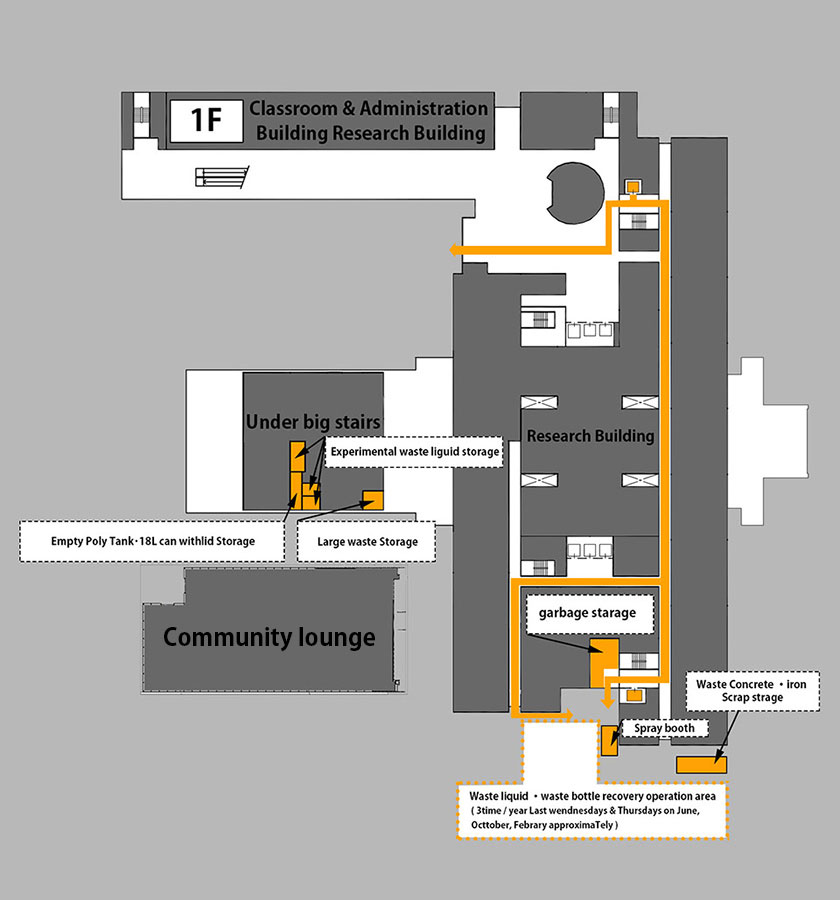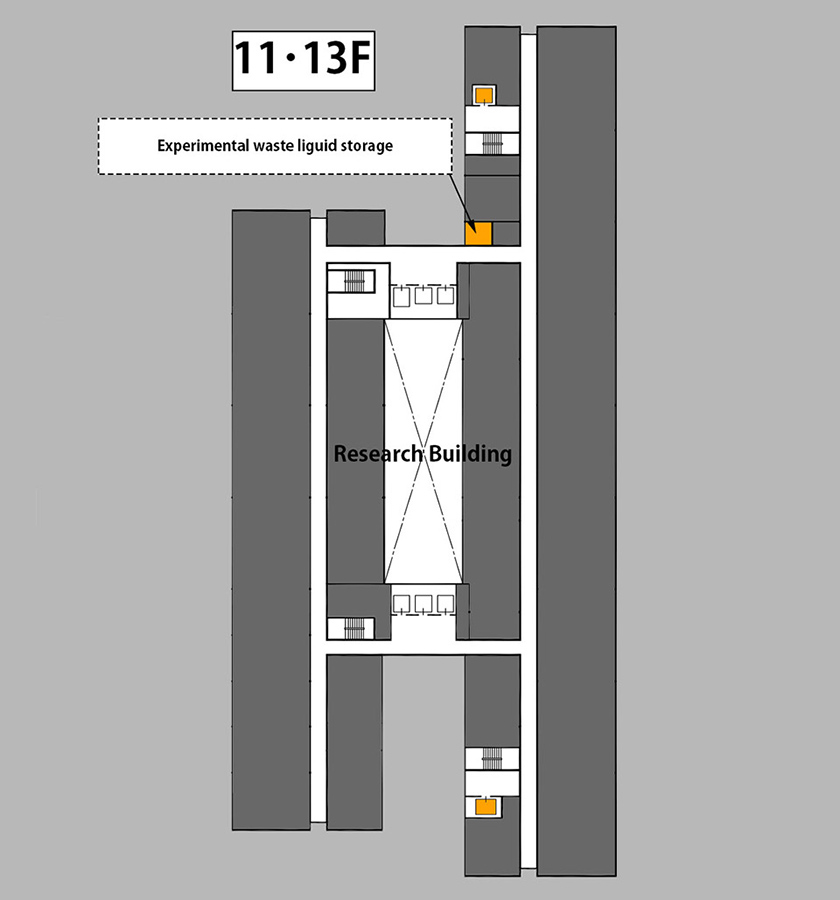Residual waste fluid
Open all
Residual waste fluid
Collection date Application form "Attachment 1"
"Collection of residual waste fluid (including waste materials) and laboratory waste"in June, October, and February -- generally on the last Wednesday 9:30 ~ 12:00 Department Specify collection time Collection place and storageLocation of poly tank (see guide map)
| Collection place | Empty poly tank storage location |
| Loading area is in front of the garbage storage facility on the Viva Home side of the research building. Use only the Cargo Elevator. Check the guide map for loading and unloading routes. Place items in front of the appropriate numbered signs near the collection desk. |
Room in front of the experimental waste repository under the large staircase You can borrow the key from the Fire Prevention Center on the first floor of the classroom building. Enter the number of polyethylene tanks to be taken out in the ledger. Contact the Facilities Department (7270) if you are out of stock |
Schedule until collection (calendar of collection month)
| sun | mon | tue | wed | thu | fry | sat | |
| week1 | Distribution of application | ||||||
| week2 | Application deadline | ||||||
| week3 | |||||||
| week4 | Distribution of seals | On the day of collection |
| Reception period | Seal application period |
Notes
Plastic bottles and other deformed plastic containers are not allowedBefore dropping off liquid waste, use an oil-based ink pen or permanent marker to draw a line indicating the “80% full” level on your polyethylene waste container. Do not fill the container above this level. Tighten the inner and outer lids tightly.
When you carry by truck
Be careful items do not fall off the dolly when passing over uneven flooring. Do not use double-tiered dollies.
【Things that cannot be treated as waste, material】
×Experimental effluent containing mercury → consult with the facility section (7270) on the 5th floor of the research building
【Things that cannot be treated as waste, material】
×Experimental effluent containing mercury → consult with the facility section (7270) on the 5th floor of the research building
Temporary storage space until collection (see guide map)
Temporary storage space until collection. Be sure to confirm that no materials are kept in temporary storage until after the application deadline| Experiment Waste Storage Under the Large Staircase | Experiment Waste Liquid Reservoir on 11th and 13th floor |
| For waste fluids covered by the ‘Treatment No. 2 and 3 Hazardous Materials of the Fire Service Act, Class 4’ Up to 10 polyethylene tanks per room Waste must be placed either within the tape divider on the floor or on the bottom row of a shelf (the top row is dangerous). Label temporarily stored items with "(Teacher's name) Lab" |
For waste liquid other than treatment no. 2 and 3 Label temporarily stored items with "(Teacher's name) Lab" Secure with a chain to prevent items from falling over Beware of polyethylene tank expansion due to a rise in room temperature. |
Waste Reagents
★ Collection date / application form "Attachment ②"
"Collection of residual waste fluid (including waste materials) and laboratory waste" in June, October, and February Generally on the last Wednesday9:30 ~ 12:00 Department Specify collection time
★ Collection place
In front of Viva Home center at the research building Front loading spaceElevator used for cargo
Confirm guide map for unloading route
Arrange collection receipts and arrange them in front of numbered tags
○Schedule until collection (calendar of collection month)
| sun | mon | tue | wed | thu | fry | sat | |
| week1 | Distribution of application | ||||||
| week2 | Application deadline | ||||||
| week3 | |||||||
| week4 | Distribution of seals | On the day of collection |
| Reception period | Seal application period |
(1) Unneeded chemicals Waste samples
★ Disposal method
For laboratories using the IASO drug management system, register empty reagent bottles and plastic chemical containers, and dispose of them in their original state.【Things that cannot be treated as waste reagent】
×Metallic Mercury · Mercury Reagent → Consult with Facility Division (7270) on the 5th floor of the Research Building
×Something that can be safely dissolved / mixed → Disposal as residual waste corresponding to process number. 1 to 15,20
×Oils → transferred to a poly tank for waste liquid and discarded as treatment number 1 "waste oil"
▲Paints · Spray → Others
(2) Silica gel · molecular sieve celite
★ Disposal method
Make sure 45L transparent plastic bags are doubled and squeeze out the air firmly.Proceed as application No. 21 "waste reagent"
【Things that cannot be treated as waste reagent】
× Adhered mercury → Consult with the facility section (7270) on the 5th floor of the research building
(3) Harmful substances adhesion chemicals Empty bottle
Those harmful substances adhere and cannot be washed【Things that cannot be treated as waste reagent】
× Adhered mercury → Consult with the facility section (7270) on the 5th floor of the research building
Experimental waste
★ Collection date and time application form "Attachment ③
""Collection of residual waste fluid (including waste reagent) and laboratory waste" in June, October, and February Generally on the last Wednesday9:30 ~ 12:00 Department Specify collection time
★ Collection place and storage area of lidded cans (see guide map)
| Collection place | Storage location for lidded cans |
|
Loading area is in front of the garbage storage facility on the Viva Home side of the research building.
Use only the Cargo Elevator. Check the guide map for loading and unloading routes. Place items in front of the appropriate numbered signs near the collection desk. |
Room in front of the experimental waste repository under the large staircase
You can borrow the key from the Fire Prevention Center on the first floor of the classroom building. Enter the number of polyethylene tanks to be taken out in the ledger. Contact the Facilities Department (7270) if you are out of stock |
(Write the name of the department and laboratory (name of the faculty member) and the month in which the disposal is planned with an oil-based ink pen.
★ Collection method
○Schedule until collection (calendar of collection month)| sun | mon | tue | wed | thu | fry | sat | |
| week1 | Distribution of application | ||||||
| week2 | Application deadline | ||||||
| week3 | |||||||
| week4 | Distribution of seals | On the day of collection |
| Reception period | Seal application period |
(1) Flammable materials such as gloves, kim-wipes, filter paper, syringes, plastics, etc.
★ Disposal method
Make sure 45L transparent plastic bags are doubled and squeeze out the air firmly.★ Notes
【Things that cannot be treated as experimental wastes】Strict prohibition of inclusion of household garbage
Apply separately for syringes and needles
Please wrap items that can break through the plastic bag, such as those with sharp edges, in newspaper or similar material.
×Infectious waste → Consult with facility section (7270)
(2) Glassware (difficult cleaning) ★ Disposal method
★ Disposal method
Put it in a lidded can but do not seal it permanently until its contents can be confirmed.Bring a sticker without pasting it contents can be confirmed.
Bring a sticker without pasting it
【Things that cannot be treated as experimental wastes】
×Wash with water or appropriate solvent (see *) → Discard these items in a laboratory chemical bottle;
(3) Sharp and dangerous tip
- Syringe integrated with needle and needle
- Pipette tip
- Surgical knife
- Other needle / insect pin
★ Disposal method
Put it in an arbitrary container but do not seal it permanently until its contents can be confirmed. Bring a sticker without pasting it contents can be confirmed. Bring a sticker without pasting it【Things that cannot be treated as experimental wastes】
×Infectious waste → Consult with facility section (7270)
Experimental medicine bottle / medicine plastic container
★ Collection date (No application is required.)
"Collection of laboratory chemical bottles (containers)" in February is on or around the final Friday 13:00 - 14:00 of the month.★ Collection method
○Schedule of collection times (calendar of collection month)| sun | mon | tue | wed | thu | fri | sat | |
| Week1 | Distribution of information | ||||||
| Week2 | |||||||
| Week3 | |||||||
| Week4 | Distribution of seals | On the day of collection |
| Seal application period |
★ Collection place and storage area for lidded cans (see guide map)
| Collection place | Storage location for lidded cans |
|
Loading area is in front of the garbage storage facility on the Viva Home side of the research building.
Use only the Cargo Elevator. Check the guide map for loading and unloading routes. Place items in front of the appropriate numbered signs near the collection desk. |
Room in front of the experimental waste repository under the large staircase
You can borrow the key from the Fire Prevention Center on the first floor of the classroom building. Enter the number of polyethylene tanks to be taken out in the ledger. Contact the Facilities Department (7270) if you are out of stock |
(1) chemical bottle (Washed)
【Things that cannot be treated as laboratory chemical bottles (containers)】×Those that cannot be removed due to adhesion of harmful substances → Disposal as treatment No.23 "waste material"
★ Disposal method
Laboratory using drug management system IASO performs empty bin registration Be sure to empty it and wash it as many times as necessary with water or an appropriate solvent, and collect the washing liquid in a polyethylene tank designated for liquid waste storage. Put a "cleaned" sticker on it → The "Cleaned Sticker" will be distributed by the Facility Management Section.Discard the caps separately.
★ Notes
It is dangerous to dispose of uncleaned items as they can react with rainwater and other chemicals, so they cannot be collected if they are not cleaned.【Things that cannot be treated as laboratory chemical bottles (containers)】
×Those that cannot be removed due to adhesion of harmful substances → Disposal as treatment No. 21 "waste reagent"
※ How many times should a bottle or container be washed with water or a suitable
solvent? Three times!
Chemicals that are water-soluble and that do not react with water → Use water Chemicals that are not water-soluble or that react with water (most Class 3 hazardous materials as defined by the Fire Service Act, with the exception of yellow phosphorus) →Use the suitable solvent
(2) Chemical plastic containers
Example: Washed chemical containers (plastic)
【Items that cannot be processed as lab chemical bottles (containers)】
Containers with hazardous material residue that cannot be removed → Dispose using
Processing Rule No. 23 (waste reagent).
★Disposal method
Labs using the IASO reagent management system should register empty bottles.
Be sure to empty each container and wash the necessary number of times with water or a suitable solvent (*see below). After washing, collect remaining liquid in a plastic tank for waste liquid.
Apply “Washed” stickers → Stickers are available at each department’s Clerical Center.
Precautions
Disposing of bottles without first washing them poses the risk of reactions with rainwater or other chemicals. If told that a bottle is unwashed, take it back with you.
Dry as much as possible.
Glass products (washed)
Example: Washed glass and ceramic lab implements
【Items that cannot be processed as lab chemical bottles (containers)】
Items with hazardous material residue that cannot be removed → Dispose using Processing No. 23 (lab waste).
★Disposal method
Wash the necessary number of times with water or a suitable solvent (see below) and collect any remaining liquid in a plastic tank for waste liquid. Apply a “Washed” sticker to the lid → The "Cleaned Sticker" will be distributed by the Facility Management Section.If full, pour into an 18 L drum, affix the lid to the drum, and seal with protective tape. If there is some space left, do not seal and only secure lid lightly.
※ How many times should a bottle or container be washed with water or a suitable solvent? Three times!
Chemicals that are water-soluble and that do not react with water → Use water Chemicals that are not water-soluble or that react with water (most Class 3 hazardous materials as defined by the Fire Service Act, with the exception of yellow phosphorus) → Use the suitable solvent
18 L can
18L Cans no chemical residue
★ Disposal method
Laboratory using drug management system IASO performs empty bin registrationBe sure to empty it, wash with water or a suitable solvent (see ※ )
Remove the lid and discard
★ Disposal place (see guide map) Large waste storage space
Batteries
(1) Lead batteries
★ Collection date Application form "Attachment 1" "Processing No.20" Other "
(1) Small rechargeable batteries
<Example>Ni-Cd battery, Ni-MH battery, Lithium ion battery
★ Disposal method
Inside of the Large waste storage space, there is a battery collection box.please borrow the key at Disaster prevention center Classroom building 1st floor
(2) Special battery
<Example> Battery manufacturing requiring discharge treatment · Consult with the purchaser to request collection(3) Dry batteries
< Example> Alkaline batteriesThere is a dedicated collection box in the room next to the freight elevator in the research building (next to the garbage storage area).
× Lead batteries, small rechargeable batteries, special batteries, laptop batteries
(4) Lead batteries
Contact to asset management section (7270)Mercury
- Metallic mercury
- Mercury thermometer
- Experimental instruments containing mercury (manometer, vacuum tube etc)
- Mercury adhesion garbage
- Fluorescent lamp
- Mercury lamp
- Mercury battery / air zinc battery
★Collection date, time and location
Any time during business hours in the facilities management section (extension 7270), 5th floor, Research Building★ When mercury is spilled
Contact the Facilities Section (7270) on class days. Contact the disaster
prevention center (7280) at night and on holidays.
- Enhance ventilation and do work with a gas mask, protective gloves, protective goggles etc.Mercury evaporates easily! There is a danger of inhaling its vapor.
- In the case of large amounts, collect with paper, a plastic plate, dropper etc. and put in containers (glass · poly) which can be sealed.
- For fine droplets of mercury, collect it using tin foil or copper wire (peal the coating off electric wire first)
- Finally, copper powder or zinc dust (neither oxidized) can be sprinkled on the mercury and,after being adsorbed, can be collected with something like a small broom.
- Bring the mercury deposits to the Facilities Section (5th floor of the research building).
Other
(1) Concrete or iron scrap
★ Disposal method (refer to the guide map)
Scrap storage → If it gets full, contact to asset management section (7270)★ When mercury is spilled
Contact the facility section (7270) on class days. Contact the disaster
prevention center (7280) at night and on holidays
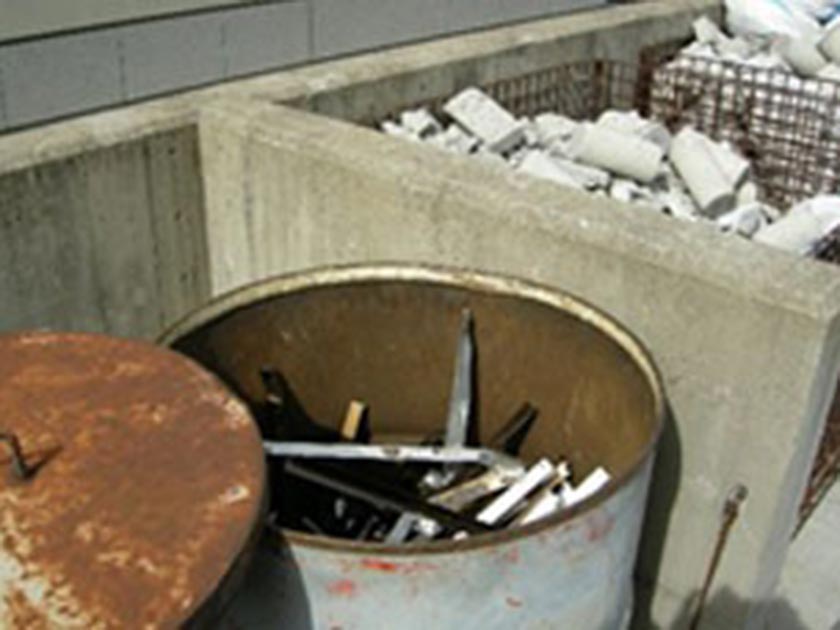 Iron scrap
Iron scrap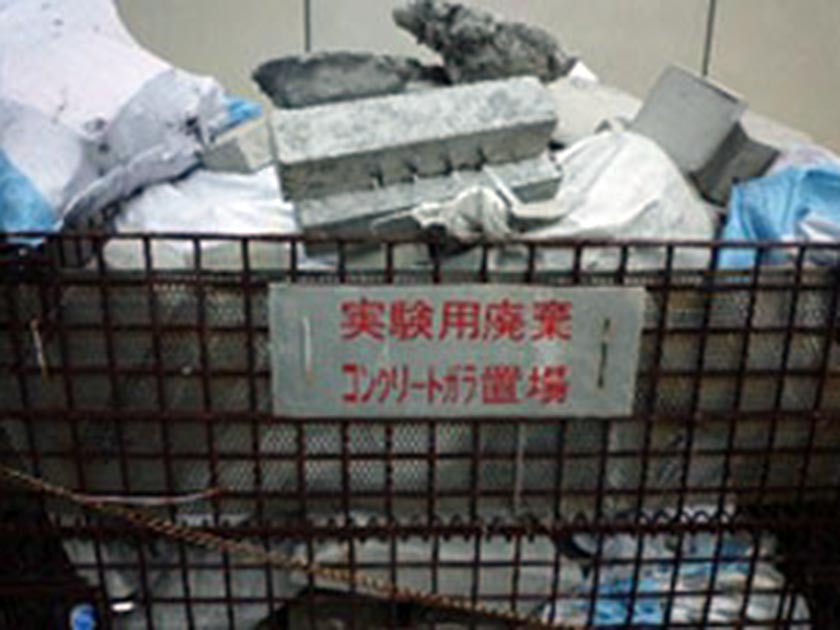 Concrete scrap
Concrete scrap★ Disposal method(refer to the guide map)
(2) Paint and Paint Spray Cans
Paint containers such as cans, bottles and plastic vessals
Paint containers such as cans, bottles and plastic vessals
- In a ventilated area (indoor/outdoor spray booth), open the lid and allow to vaporize or solidify completely with the treatment agent.
- Put it in a double-layered plastic bag soaked with newspaper, etc., and apply for treatment number 22 "Experimental Waste".
- Put the oil in a polyethylene tank for disposal and apply for treatment number 1 "Waste Oil".Paint
- Soak it in newspaper or similar material in a ventilated place, and place it in a double-layered plastic bag with the treatment number 22 (Experimental Waste). Paint Spray Cans
- Completely vent the gas and then put the can in the bulky waste dumpster.
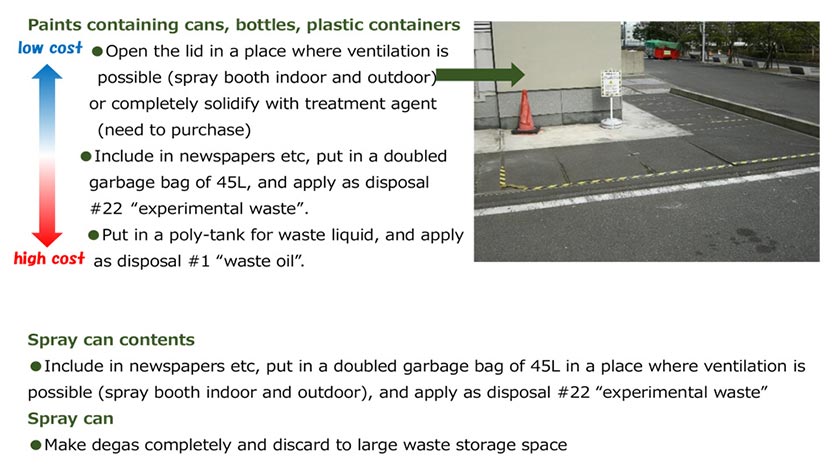
(3) Experimental machines ·Expendable supplies
Please contact the Asset management section (7270) before disposing of the following items- Large laboratory equipment
- PC equipment (things that battery can sort out)
- Furniture
- Fluorescent tubes
- Button batteries
(4) Empty cylinders
Spent high pressure gas cylinders are returned to the supplier [TOMOE(03-5735-4311) ]
(5) Model waste
★ Disposal method
Models are classified as household garbage Be sure to sort the waste wood, board,corrugated cardboard, and panels.
Use the "large amount garbage disposal reservation slip", go to the disaster prevention
center and submit it by 15 o'clock of the day before pick up
↓
Get a notification of reservation acceptance from the cleaning officer
↓
Bring it to the garbage disposal room at 3:15 PM
【Things that cannot be treated as model waste】
×Not sorted as household garbage
Not experimental garbage (household garbage)
★ Disposal method Refer to sorting table installed in predetermined place
- Burnable garbage bin: Waste paper · Cloths · Small wood chips (fragments) ·Flowers
- Incombustible garbage bin: lunch containers · vinyl · plastic · rubber · leatherproducts · portable warmer · metal ware · glass · pottery · spray cans, oil (salad oil,tuna can)
- Bottle/ can bin: plastic bottles Drink leftover of beverages is emptied anddiscarded, lid removed andincombustible waste
- Oversized waste storage (size more than 30 cm) · Experimental equipment · Homeappliances
- Other garbage. books → cardboard tied with vinyl strings etc (up to 60 cm on a side)
- Cutlery · tableware etc (wrapped in thick paper and labeled “danger”)
【Things that cannot be treated as household garbage】
×Experimental waste
★ Notes
For safety and efficient processing by workers, do not mix laboratory waste into household garbage!★ When chemical substances are spilled
- Contact the facility section (7270) on class days, and contact the disaster prevention center (7280) at night and on holidays.
| On-campus / telephone response |
|
Chemical substances were scattered at XX on the XX floor of XX building.
The chemical is ○ ○.
The person has been injured or exposed to chemicals.
Other damage situation ... (quantity, state of reaction) ... Please support me.
I am a (faculty member) graduate △△.
|
- Check the safety data sheet (SDS), or retrieve it by smartphone.
- Ventilate (open the window, take in outside air · press ventilation switch) well.
- In the case of a substance with a strong toxicity, help people evacuate from the floor.
- Fire Law Dangerous Goods Class 4 Special Flammable Materials In case of highly flammable substances, it is strictly prohibited to use electrical devices and switches!
- Work should be done with a gas mask, protective gloves, protective goggles etc.
Disposal place guide map
